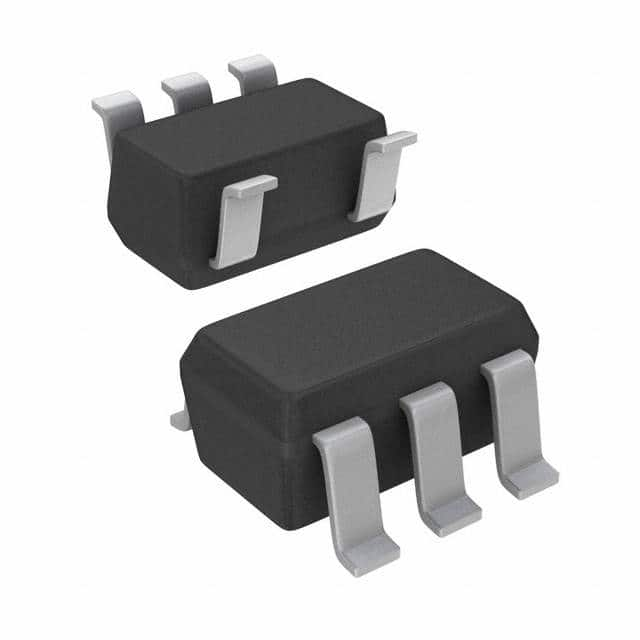TL431AQDBVRE4
Product Overview
- Category: Integrated Circuit (IC)
- Use: Voltage reference and shunt regulator
- Characteristics: Adjustable precision, low voltage reference, high accuracy, low quiescent current
- Package: SOT-23-6 package
- Essence: Precision adjustable shunt regulator
- Packaging/Quantity: Tape and reel packaging, 3000 units per reel
Specifications
The TL431AQDBVRE4 is a precision adjustable shunt regulator IC that provides a highly accurate voltage reference. It is designed to be used in various applications where a stable voltage reference or a shunt regulator is required. The key specifications of the TL431AQDBVRE4 are as follows:
- Reference Voltage Range: 2.495V to 36V
- Output Current: Up to 100mA
- Operating Temperature Range: -40°C to +85°C
- Reference Voltage Tolerance: ±1%
- Quiescent Current: 1.0mA (typical)
Pin Configuration
The TL431AQDBVRE4 is a 6-pin SOT-23 package with the following pin configuration:
- Anode (A)
- Cathode (K)
- Reference Voltage (Vref)
- N/C (No Connection)
- N/C (No Connection)
- N/C (No Connection)
Functional Features
The TL431AQDBVRE4 offers the following functional features:
- Adjustable Output Voltage: The reference voltage can be adjusted using external resistors to set the desired output voltage.
- High Accuracy: The TL431AQDBVRE4 provides a highly accurate reference voltage with a tolerance of ±1%.
- Low Quiescent Current: The IC has a low quiescent current of 1.0mA, making it suitable for low-power applications.
- Wide Operating Voltage Range: The TL431AQDBVRE4 can operate within a wide voltage range from 2.495V to 36V.
Advantages and Disadvantages
Advantages of the TL431AQDBVRE4 include:
- High accuracy and precision
- Adjustable output voltage
- Low quiescent current
- Wide operating voltage range
Disadvantages of the TL431AQDBVRE4 include:
- Limited output current capability (up to 100mA)
- Requires external resistors for voltage adjustment
Working Principles
The TL431AQDBVRE4 operates as a shunt regulator by comparing the reference voltage (Vref) with the feedback voltage. It adjusts the current flowing through the cathode (K) and anode (A) pins to maintain a stable output voltage. By adjusting the external resistors connected to the reference voltage pin, the desired output voltage can be set.
Detailed Application Field Plans
The TL431AQDBVRE4 is widely used in various applications, including:
- Power Supplies: It is commonly used as a voltage reference in power supply circuits to provide stable and accurate voltages.
- Battery Charging Systems: The TL431AQDBVRE4 can be used in battery charging systems to regulate the charging voltage and ensure proper charging.
- Audio Amplifiers: It can be employed in audio amplifier circuits to provide a stable bias voltage for improved audio performance.
- Industrial Control Systems: The IC finds application in industrial control systems where precise voltage references are required for accurate measurements and control.
Detailed and Complete Alternative Models
Some alternative models to the TL431AQDBVRE4 include:
- TL431BQDBZR: Similar to TL431AQDBVRE4, but with a different package (SOT-23-3).
- TLV431BQDBZR: A low-voltage version of the TL431AQDBVRE4, with a reference voltage range from 0.6V to 6V.
- LM4040AIM3-2.5/NOPB: A precision shunt regulator IC with a fixed 2.5V output voltage.
These alternative models offer similar functionality and can be used as substitutes depending on specific requirements.
In conclusion, the TL431AQDBVRE4 is a precision adjustable shunt regulator IC that provides a highly accurate voltage reference. It offers adjustable output voltage, high accuracy, and low quiescent current. With its wide operating voltage range, it finds applications in power supplies, battery charging systems, audio amplifiers, and industrial control systems. Alternative models such as TL431BQDBZR, TLV431BQDBZR, and LM4040AIM3-2.5/NOPB can be considered based on specific needs.
قم بإدراج 10 أسئلة وإجابات شائعة تتعلق بتطبيق TL431AQDBVRE4 في الحلول التقنية
Sure! Here are 10 common questions and answers related to the application of TL431AQDBVRE4 in technical solutions:
Q: What is TL431AQDBVRE4? A: TL431AQDBVRE4 is a programmable precision voltage reference that can be used in various applications such as voltage regulation, feedback control, and precision measurement.
Q: What is the operating voltage range of TL431AQDBVRE4? A: The operating voltage range of TL431AQDBVRE4 is typically from 2.5V to 36V.
Q: How does TL431AQDBVRE4 work? A: TL431AQDBVRE4 operates by comparing the reference voltage with an external voltage divider network. It adjusts its output voltage to maintain a constant reference voltage.
Q: Can TL431AQDBVRE4 be used for voltage regulation? A: Yes, TL431AQDBVRE4 is commonly used for voltage regulation applications due to its high accuracy and low temperature coefficient.
Q: What is the typical output voltage range of TL431AQDBVRE4? A: The typical output voltage range of TL431AQDBVRE4 is from 2.5V to 36V.
Q: Is TL431AQDBVRE4 suitable for precision measurement applications? A: Yes, TL431AQDBVRE4 is suitable for precision measurement applications due to its high accuracy and low drift characteristics.
Q: Can TL431AQDBVRE4 be used as a shunt regulator? A: Yes, TL431AQDBVRE4 can be used as a shunt regulator by connecting it between the load and ground to regulate the voltage across the load.
Q: What is the temperature range for TL431AQDBVRE4? A: The temperature range for TL431AQDBVRE4 is typically from -40°C to 125°C.
Q: Can TL431AQDBVRE4 be used in automotive applications? A: Yes, TL431AQDBVRE4 is qualified for automotive applications and meets the AEC-Q100 standard.
Q: Are there any recommended application circuits for TL431AQDBVRE4? A: Yes, the datasheet of TL431AQDBVRE4 provides several recommended application circuits for different use cases, such as voltage regulation, current limiting, and overvoltage protection.
Please note that these answers are general and may vary depending on specific design requirements and application conditions. It's always recommended to refer to the datasheet and consult with technical experts for detailed information and guidance.


